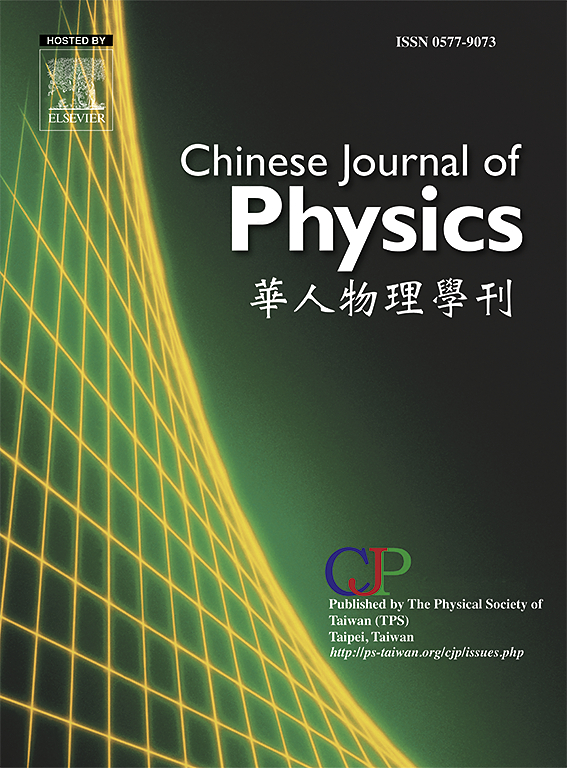A novel fractional hybrid nanofluid model for blood flow in a stenosed artery with a peripheral plasma layer: Narrowing the gap between Bingham’s model and experiments
IF 4.6
2区 物理与天体物理
Q1 PHYSICS, MULTIDISCIPLINARY
引用次数: 0
Abstract
Understanding blood flow is crucial for improving drug delivery, cardiovascular health, and treatments. This study introduces a novel fractional model for blood flow in stenosed arteries using a - hybrid nanofluid within a two-fluid framework. Red blood cells are modeled as a non-Newtonian Bingham fluid, while plasma is treated as a Newtonian fluid. The formulation incorporates a fractional-order momentum equation, a dual-phase lag fractional energy equation, considering phase lags, a magnetic field, porosity, and thermal radiation. The use of fractional calculus in combination with the two-phase flow approach is intended to capture the complex rheological behavior of blood, including memory effects and non-local characteristics that are often neglected in traditional models. This approach aims to enhance the accuracy of the classical Bingham model and bridge the noticeable gap between its predictions and experimental results. Finite difference methods with Caputo L1 fractional derivatives solve the dimensionless equations. Key parameters analyzed include the Hartmann number, thermal radiation, Darcy number, and fractional orders (, , ). Results reveal their impact on velocity, temperature, flow rate, wall shear stress, and the Nusselt number. It is found that the fractional Bingham model with plasma outperforms classical models across all degrees of stenosis when compared to experimental data, most notably in mild stenosis, with only a 0.3% error in time-averaged velocity. For the fractional Bingham model, a fractional order of = 0.6 aligns best with experimental results across all three stenosis cases, while the hybrid nanofluid enhances both flow and heat transfer. These findings offer insights for biomedical applications, including therapeutic interventions and device design.

一种新的带有外周血浆层的狭窄动脉血流的分数混合纳米流体模型:缩小Bingham模型和实验之间的差距
了解血流对改善药物输送、心血管健康和治疗至关重要。本研究在两流体框架内使用TiO2-Au混合纳米流体引入了一种新的血管狭窄血流分数模型。红细胞被建模为非牛顿的宾厄姆流体,而血浆被处理为牛顿流体。该公式结合了一个分数阶动量方程,一个双相滞后分数能量方程,考虑了相位滞后、磁场、孔隙度和热辐射。分数微积分结合两相流方法的使用旨在捕捉血液的复杂流变行为,包括记忆效应和非局部特征,这些在传统模型中经常被忽略。这种方法旨在提高经典Bingham模型的准确性,弥合其预测与实验结果之间的明显差距。卡普托L1分数阶导数有限差分法求解无量纲方程。分析的关键参数包括Hartmann数、热辐射、Darcy数和分数阶(α1、α2、β)。结果揭示了它们对速度、温度、流量、壁面剪应力和努塞尔数的影响。研究发现,与实验数据相比,含等离子体的分数Bingham模型在所有狭窄程度上都优于经典模型,最明显的是在轻度狭窄情况下,时间平均速度误差仅为0.3%。对于分数阶Bingham模型,α1 = 0.6的分数阶与实验结果最吻合,而混合纳米流体同时增强了流动和传热。这些发现为包括治疗干预和设备设计在内的生物医学应用提供了见解。
本文章由计算机程序翻译,如有差异,请以英文原文为准。
求助全文
约1分钟内获得全文
求助全文
来源期刊

Chinese Journal of Physics
物理-物理:综合
CiteScore
8.50
自引率
10.00%
发文量
361
审稿时长
44 days
期刊介绍:
The Chinese Journal of Physics publishes important advances in various branches in physics, including statistical and biophysical physics, condensed matter physics, atomic/molecular physics, optics, particle physics and nuclear physics.
The editors welcome manuscripts on:
-General Physics: Statistical and Quantum Mechanics, etc.-
Gravitation and Astrophysics-
Elementary Particles and Fields-
Nuclear Physics-
Atomic, Molecular, and Optical Physics-
Quantum Information and Quantum Computation-
Fluid Dynamics, Nonlinear Dynamics, Chaos, and Complex Networks-
Plasma and Beam Physics-
Condensed Matter: Structure, etc.-
Condensed Matter: Electronic Properties, etc.-
Polymer, Soft Matter, Biological, and Interdisciplinary Physics.
CJP publishes regular research papers, feature articles and review papers.
 求助内容:
求助内容: 应助结果提醒方式:
应助结果提醒方式:


